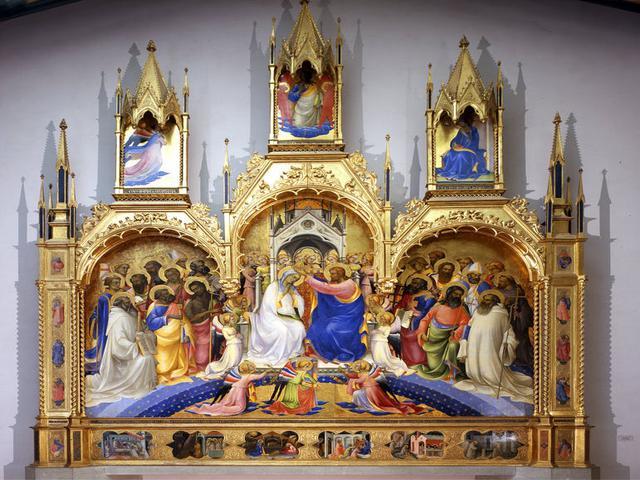Coronation of the Virgin

The inscription at the bottom, which was partially restored in the 19th century, shows that the large altarpiece was commissioned by Zanobi di Cecco del Frasca for the main altar of the church in the Camaldolese abbey of Santa Maria degli Angeli in Florence and that it was Painted by Don Lorenzo, a monk who lived in the abbey. The date of the inscription, February 1413, corresponds, according to our current calendar, to February 1414, since it was not until the 18th century that the year began in Florence, on March 25, the feast of the Annunciation.
The altarpiece is large in size, rich in composition and sumptuously decorated. Christ and the Virgin are seated on a throne, while the son crowns Mary before the angels and numerous saints, kneeling at the sides of the painting. These include, dressed in the white robes of the Camaldolese order, Saint Benedict, on the left, and Saint Romuald on the right, respectively, the founder of Western monasticism and the Camaldolese order. The scene, which is a single scene, despite the three-part form of the altarpiece, is located on a starry rainbow, the symbolic representation of the celestial spheres that formed the universe, according to medieval cosmology.
Within the pinnacles above the main scene is the Annunciation, with God the Father in the center, while at the bottom, the predella, with mixtilinear tiles typical of Gothic decorations, shows the Nativity of Jesus and the Adoration of the Magi in the Center, and four episodes from the life of Saint Benedict on the sides.
Lorenzo Monaco, one of the main exponents of late Gothic painting in Florence, in addition to being a well-known miniature artist, was able to put his personal figurative language at the service of Calmaldolese spirituality, demonstrating the sense of transcendence expressed in the Intense and reflective faces of the saints present at this sacred event, thanks to the slender shapes of the bodies and the sophisticated linear intervals of the clothing.
© Tourblink